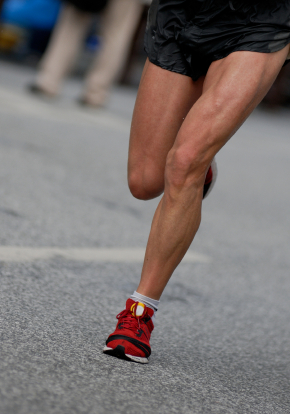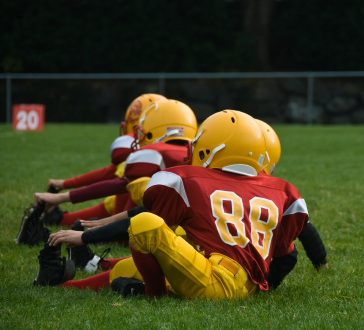A lot has been written about the subject of stretching and flexibility in sports. Studies abound on the effects of flexibility on muscular strength, joint motion, and injury prevention, but the picture seems to become more muddled with every passing day, with even the conventional wisdom that static stretching improves flexibility over resistance training recently called into question. But the fact remains: stretching improves flexibility, a foundation for athletic success.
It's time to get back to basics and answer three questions:
-
Why does an athlete need to stretch?
-
How much should an athlete stretch? and
- What is an appropriate stretching program for my child?
Why stretch?
The main reason for stretching is to maximize available movement with minimal internal restrictions from soft tissue. Essentially, stretching limbers up the muscles so energy is focused on completing a task, not fighting against the body.
Stretching allows athletes to kick higher, reach longer, and generally move without bodily limitations.
Unlike strength, speed, or power, flexibility does not fall into the category of "more is better." There is such a thing as too much flexibility, where an athlete's joints are too loose and instability leads to injury and early arthritis.
On the hand, too little flexibility limits an athlete's available motion and control and may increase the risk of tearing a muscle, tendon, or other tissue due to inelasticity (although the research on this point is cloudy).
How much stretching?
Before you enroll your child in a yoga class to increase her flexibility, there are three main factors to consider in determining his flexibility needs:
1. Individual and Sport Variables
- Genetics. Some athletes are just naturally more flexible, some are simply not. If your child isn't naturally flexible he will need to spend more time and effort obtaining and maintaining an appropriate level of flexibility than a naturally flexible athlete.
- Injury history. Soft tissue injuries, such as sprains and strains, will only regain 80% of original flexibility. This means an athlete who has suffered a serious injury will need to do more stretching to maintain flexibility because of scar tissue that has built up from the injury.
- Sport. Long distance runners don't need that much hamstring flexibility, ballet and sprinters need much more. The stretching program needs to be tailored to the specific sport or activity and what is necessary to be successful and move fluidly in that sport or activity.

- Environment. Cold weather means tighter muscles; hot weather equals looser muscles.
2. Muscles prone to tightness
Here are the muscles that are prone to tightness and may need to be stretch to provide the necessary degree of flexibility appropriate for that athlete in that particular sport:
- Hamstrings (back of thigh)
- Hip Flexors (front of hip)
- Hip Adductors (groin)
- Rectus Femoris (thigh muscle)
- Gastrocs (calves)
- Pectoralis Major (chest)
- Latissimus Dorsi (back)
- Deep Back/Core Muscles
For some simple tests to determine flexibility of the major muscles used in soccer, click here.
3. Commitment
Stretching requires a commitment of time. Some have it, some don't, some fall in-between.
Athletes fall across a spectrum. Some:
- Stretch regularly and often, using good form;
- Stretch sometimes, but always make stretching a priority when necessary;
- Fit stretching in on occasion, will get in 10 minutes of stretching before a game;
- Don't stretch too much, might stretch if everyone else on the team does;
- Don't stretch at all, don't have the time, and prefer to lift and run instead.
Determining stretching needs
Considering these three main factors will help a young athlete figure out their stretching needs. The reason for finding a balance is that the benefits of flexibility, like the grades of a class in school, fall on bell curve, with extremes on the ends and a sweet spot in the middle:
- If an athlete is too inflexible, there is risk of injury, less joint mobility and control, and inability to produce motion ideal for their particular sport.
- If an athlete is too loose, the joints are at risk for instability and dislocation.
- An athlete that spends no time stretching, is naturally inflexible, has a history of tight hamstrings, and is playing in the cold should probably spend more time stretching.
- A cross country runner with average to good flexibility, with no history of muscle or tendon injuries, but who nevertheless spends 30 minutes stretching every day, is likely overdoing it.
Designing the right stretching program
By understanding the basics and tailoring a stretching program to an individual athlete's needs, sport, injury history, and level of commitment, a proper stretching program can be designed that the athlete will actually follow.
A well-designed stretching program might include the following elements:
- Warming up (jogging) before competition to warm tissue to prepare muscles for movement
- Static stretching (holding for 20-60 seconds) to increase tissue extensibility

- Dynamic stretching (lunges, squats, stretching with movement) to decrease tissue stiffness and maximize current tissue extensibility
Which is best? The answer is all of them, in balance:
First, of all, every athlete should warm up before competition. The body needs to prepare for intense movement and muscle contractions and an elevated body temperature increasing soft tissue extensibility.
Dynamic versus static stretching
What about dynamic versus static stretching? The answer to that question takes us back to the first two questions asked above: (1) why do athletes need to stretch?; and (2) how much should athletes stretch?
- Static stretching does an excellent job of increasing the length of muscle tissue. The downside is that right before competition, static stretching can decrease muscular strength and power. This could increase risk of injury (example: muscle has elongated in length and body is not able to control the muscle due to weakness) or decrease performance.
- Dynamic stretching decreases muscular stiffness, preparing the body to maximize its current level of flexibility. Unfortunately, some research has concluded that to turn off the mechanisms that prevent muscles from getting longer, holding stretches for longer periods may be necessary. Dynamic stretching may not increase tissue length in very inflexible individuals.
Finding balance
So, here's the bottom line:
- For athletes who are very flexible and playing in ideal conditions, dynamic stretching before a competition is likely enough to maximize performance while minimizing risk of injury.
- For less flexible athletes, static stretching on a regular basis to increase tissue length is ideal (20-30 minutes at least 3 days a week).
- For all athletes, long static holds before a competition are not recommended. The body goes into competition with the ability to control what it has trained to control, which means that too much static stretching before a competition will change the way muscles fire to produce movement and protect joints. Furthermore, the decrease in power and strength output could put the athlete at risk for injury.
Yes to stretching
When it comes to the question of stretching, the first answer should always be "yes." Too often, young athletes overlook this very basic component of sports preparation because it is boring, they are inpatient, and throwing, catching, or shooting a ball is much more interesting.
Flexibility is a fundamental building block in sports performance, an important factor along with core training, balance, proprioception (e.g. the sense that indicates whether the body is moving with required effort, as well as where the various parts of the body are located in relation to each other), and joint stability and mobility.
The more interesting dynamics of athletic training - including speed, power, endurance, reaction, quickness, etc. - all build off of the building blocks of training, including maintaining/improving flexibility. Understanding the basic components of why, how, and what in respects to stretching are critical for long term athletic success.
Keith J. Cronin is a physical therapist in the St. Louis, Missouri area and a MomsTeam expert








